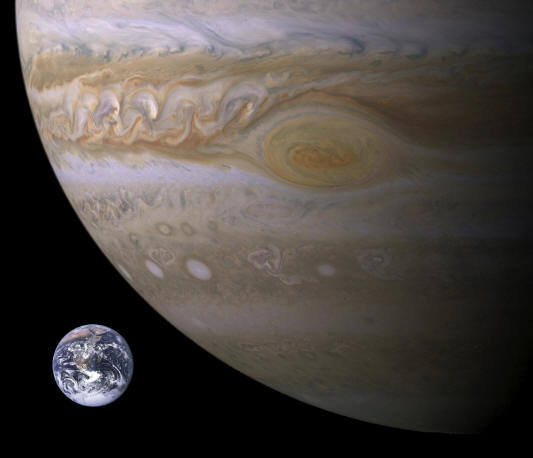|
The Night Sky of November
Dr. Wayne Wooten
Professor of Astronomy
For November, the Moon will be first quarter on November 3rd, so the first two weeks of November will thus find the Moon waxing in the evening skies. November 6th marks the day to fall back to CST for 2011. The full moon for November is the Frosty Moon, and falls on November 10th; it passed just 5 degrees north of bright Jupiter
the previous evening. The last quarter moon passes seven degrees south of Mars on November 18th, with both rising in the northeast about midnight. Saturn is now back in the morning sky, and the waning crescent moon passes six degrees south of it on the morning of November 22nd. The new moon is on November 25th, and the waxing crescent moon passes three degrees
north of Venus is SW evening twilight on the 27th. This crescent moon marks the Muslim new year, year 1433 AH in the lunar based year calculations.
If you have clear skies and a flat western horizon, you can watch an interesting series of groupings involving the inner planets Mercury and Venus and the star Antares right after sunset the first weeks of November. On the 1st, Mercury is two degrees south of Venus. The crescent moon passed them on October 27th. Mercury rapidly
climbs higher than Venus until it begins retrograding back toward the Sun; it passes Venus again, now heading westward, passing two degrees south of brighter Venus on the 14th, and is lost in sun’s glare within next two weeks. Much farther away, reddish Antares in Scorpius is passed by both Mercury and Venus on the 10th, with all three objects in the same
binocular field. Venus continues climbing higher in the evening sky for the next six months, but will appear as a tiny, bright disk telescopically, still on the far side of the Sun.
Giant Jupiter dominates the SW sky in Aries at the beginning of November. Any small scope will reveal what Galileo marveled at four hundred years ago; four large moons, all bigger or similar to ours in size, orbit it in a line along Jupiter’s equator. So get out the old scope, and focus on Jupiter for a constantly changing dance of
the moons around the giant world. Out photo this month shows the famed Great Red Spot in October 2010; it is not as obvious now, for the south equatorial belt.

Setting in the southwest is the teapot shape of Sagittarius, which marks the heart of our Milky Way Galaxy, but the best view of our Galaxy lies overhead now. The brightest star of the northern hemisphere, Vega dominates the sky in the northwest. To the northeast of Vega is Deneb, the brightest star of Cygnus the Swan. To the south
is Altair, the brightest star of Aquila the Eagle, the third member of the three bright stars that make the Summer Triangle so obvious in the NE these clear autumn evenings. Use binocs and your sky map to spot many clusters.
Overhead the square of Pegasus is a beacon of fall. South of the square is the only bright star of Fall, Fomalhaut. If the southern skies of Fall look sparse, it is because we are looking away from our Galaxy into the depths of intergalactic space. But big scopes do reveal many distant galaxies in this stellar wasteland.
The constellation Cassiopeia makes a striking W, rising in the NE as the Big Dipper sets in the NW. Polaris lies about midway between them. She contains many nice star clusters for binocular users in her outer arm of our Milky Way, extending to the NE now. Her daughter, Andromeda, starts with the NE corner star of Pegasus’’ Square,
and goes NE with two more bright stars in a row. It is from the middle star, beta Andromeda, that we proceed about a quarter the way to the top star in the W of Cassiopeia, and look for a faint blur with the naked eye. M-31, the Andromeda Galaxy, is the most distant object visible with the naked eye, lying about 2.5 million light years distant.
To the northeast, Andromeda’s hero, Perseus, rises. Between him and Cassiopeia is the fine Double Cluster, faintly visible with the naked eye and two fine binocular objects in the same field. Perseus contains the famed eclipsing binary star Algol, where the Arabs imagined the eye of the gorgon Medusa would lie. It fades to a third
its normal brightness for six out of every 70 hours, as a larger but cooler orange giant covers about 80% of the smaller but hotter and thus brighter companion as seen from Earth. Check it out on a clear November evening, and see it the gorgon is winking at you. If so, then instead of being as bright as Polaris, Algol fade to be only as bright as kappa Persei, the
star just to its south. Look at Perseus’ feet for the famed Pleiades cluster to rise, a sure sign of bright winter stars to come. In fact, yellow Capella, a giant star the same temperature and color as our much smaller Sun, rises at 7 PM as November begins along the northeastern horizon. It is the fifth brightest star in the sky, and a beacon of the colorful and
bright winter stars to come.
Read past issues of the Sky at Night
|